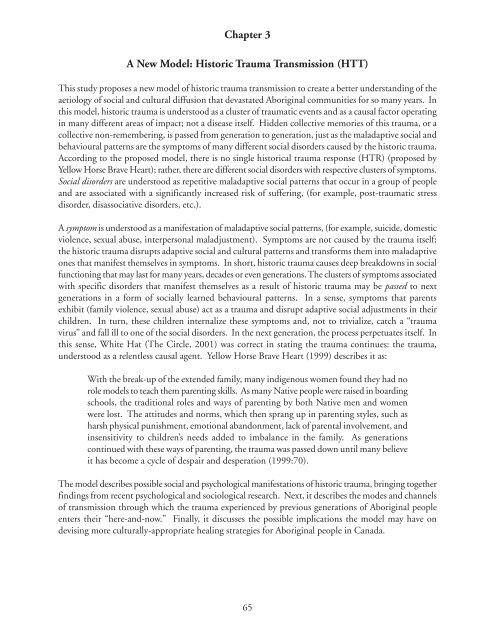Historic Trauma and Aboriginal Healing
by Cynthia C. Wesley-Esquimaux, Ph.D. and Magdalena Smolewski, Ph.D.
by Cynthia C. Wesley-Esquimaux, Ph.D. and Magdalena Smolewski, Ph.D.
Create successful ePaper yourself
Turn your PDF publications into a flip-book with our unique Google optimized e-Paper software.
Chapter 3<br />
A New Model: <strong>Historic</strong> <strong>Trauma</strong> Transmission (HTT)<br />
This study proposes a new model of historic trauma transmission to create a better underst<strong>and</strong>ing of the<br />
aetiology of social <strong>and</strong> cultural diffusion that devastated <strong>Aboriginal</strong> communities for so many years. In<br />
this model, historic trauma is understood as a cluster of traumatic events <strong>and</strong> as a causal factor operating<br />
in many different areas of impact; not a disease itself. Hidden collective memories of this trauma, or a<br />
collective non-remembering, is passed from generation to generation, just as the maladaptive social <strong>and</strong><br />
behavioural patterns are the symptoms of many different social disorders caused by the historic trauma.<br />
According to the proposed model, there is no single historical trauma response (HTR) (proposed by<br />
Yellow Horse Brave Heart); rather, there are different social disorders with respective clusters of symptoms.<br />
Social disorders are understood as repetitive maladaptive social patterns that occur in a group of people<br />
<strong>and</strong> are associated with a significantly increased risk of suffering, (for example, post-traumatic stress<br />
disorder, disassociative disorders, etc.).<br />
A symptom is understood as a manifestation of maladaptive social patterns, (for example, suicide, domestic<br />
violence, sexual abuse, interpersonal maladjustment). Symptoms are not caused by the trauma itself;<br />
the historic trauma disrupts adaptive social <strong>and</strong> cultural patterns <strong>and</strong> transforms them into maladaptive<br />
ones that manifest themselves in symptoms. In short, historic trauma causes deep breakdowns in social<br />
functioning that may last for many years, decades or even generations. The clusters of symptoms associated<br />
with specific disorders that manifest themselves as a result of historic trauma may be passed to next<br />
generations in a form of socially learned behavioural patterns. In a sense, symptoms that parents<br />
exhibit (family violence, sexual abuse) act as a trauma <strong>and</strong> disrupt adaptive social adjustments in their<br />
children. In turn, these children internalize these symptoms <strong>and</strong>, not to trivialize, catch a “trauma<br />
virus” <strong>and</strong> fall ill to one of the social disorders. In the next generation, the process perpetuates itself. In<br />
this sense, White Hat (The Circle, 2001) was correct in stating the trauma continues: the trauma,<br />
understood as a relentless causal agent. Yellow Horse Brave Heart (1999) describes it as:<br />
With the break-up of the extended family, many indigenous women found they had no<br />
role models to teach them parenting skills. As many Native people were raised in boarding<br />
schools, the traditional roles <strong>and</strong> ways of parenting by both Native men <strong>and</strong> women<br />
were lost. The attitudes <strong>and</strong> norms, which then sprang up in parenting styles, such as<br />
harsh physical punishment, emotional ab<strong>and</strong>onment, lack of parental involvement, <strong>and</strong><br />
insensitivity to children’s needs added to imbalance in the family. As generations<br />
continued with these ways of parenting, the trauma was passed down until many believe<br />
it has become a cycle of despair <strong>and</strong> desperation (1999:70).<br />
The model describes possible social <strong>and</strong> psychological manifestations of historic trauma, bringing together<br />
findings from recent psychological <strong>and</strong> sociological research. Next, it describes the modes <strong>and</strong> channels<br />
of transmission through which the trauma experienced by previous generations of <strong>Aboriginal</strong> people<br />
enters their “here-<strong>and</strong>-now.” Finally, it discusses the possible implications the model may have on<br />
devising more culturally-appropriate healing strategies for <strong>Aboriginal</strong> people in Canada.<br />
65


















